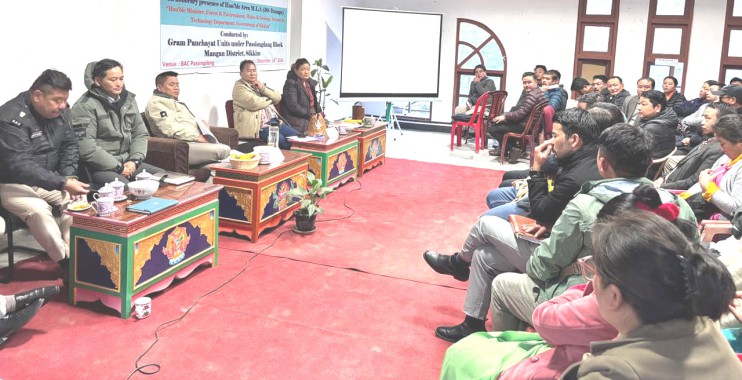




















Tuesday, Dec 17, 2024 10:30 [IST]
Last Update: Tuesday, Dec 17, 2024 04:59 [IST]
GANGTOK,: The Gram Panchayat Development Plan (GPDP) serves as a crucial
instrument of self-governance under the Panchayati Raj Institution (PRI)
framework, embodying the essence of grassroots planning and inclusive
development.
Recognizing
the transformative potential of participatory governance, the seven GPUs of
Dzongu block convened a Joint Gram Planning Forum in collaboration with BAC,
Passingdang on Monday at the Block Administrative Centre (BAC), Passingdang,
Mangan District. This initiative exemplifies the commitment to aligning the
voices of local communities with developmental aspirations, a press release
informs.
Area MLA
Pintso Namgyal Lepcha, also the Forest minister, attended the meeting as an
observer.
Demonstrating
his unwavering dedication to Dzongu’s progress, the minister prioritized this
significant forum, cancelling a high-level meeting scheduled at Rholu. The
session was chaired by panchayat president Dawa Tshering Lepcha, with
Up-Adhakshya, Mangan District, Sonam Kipa Bhutia, serving as the co-chairperson.
This
collaborative event brought together a diverse array of participants, including
panchayat presidents, vice presidents, members, PRI functionaries, senior VAA,
PDAs of all GPUs, BDO Passingdang, BAC officials, SDM Dzongu, joint director
cum RO Dzongu block, Additional Superintendent of Police, CEO Education department,
HoDs, and representatives from various line departments.
At the
outset, an engaging presentation by the deputy director, SIRD, outlined the
significance of Gram Sabha, Gram Planning Forum, and the GPDP process,
emphasizing the role of collective vision in fostering sustainable development.
The forum
featured the presentation of draft GPDPs from all seven GPUs-Lum Gor Sangtok,
Hee Gyathang, Lingdong Barfok, Passingdang Saffo, Lingthem Lingdem, Tingvong,
and Sakyong Pentong GPU. These plans, developed through intensive community
consultations, highlighted priority areas such as infrastructure, education,
healthcare, and livelihood enhancement.
Additionally,
representatives from line departments presented their schemes and programmes,
ensuring alignment with the needs articulated in the GPDPs. This integration
fosters a synergy between local aspirations and government policies, ensuring
resource optimization and effective implementation.
The zero
hour provided a platform for the panchayat representatives to voice pressing
concerns and development challenges to the line departments. Issues ranged from
infrastructure gaps to capacity-building needs, all of which were addressed
with actionable responses by the departmental representatives.
The
minister-cum-area MLA applauded the initiative, recognizing the tireless
efforts of the Gram Panchayats and BAC Passingdang in orchestrating such a
comprehensive platform for dialogue. He reaffirmed the government’s unwavering
commitment to fulfilling the developmental aspirations of Dzongu and emphasized
the importance of inclusive decision-making in shaping sustainable roadmaps,
the release mentions.
The forum
concluded with the reading and signing of the minutes of the meeting,
symbolizing a collective commitment to the agreed-upon priorities. The minister
underscored the significance of this initiative as a model for participatory
governance, where all stakeholders collaboratively envision and execute
development plans.
This Gram
Planning Forum serves as a pivotal step in fostering an inclusive, transparent,
and sustainable approach to governance in Dzongu, the release adds.
